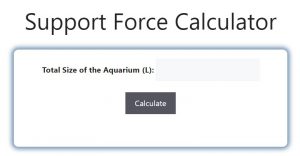About Support Force Calculator (Formula)
The Support Force Calculator is a practical tool used in physics to determine the force exerted by a surface in response to the weight of an object or objects resting on it. Understanding support force is crucial for analyzing static systems, such as structures and mechanical components. By knowing the mass of the objects involved and the gravitational acceleration, you can quickly compute the support force acting on them. This article will guide you through the formula, how to use the calculator, and provide useful examples and FAQs.
Formula
The formula for calculating the support force is:
Support Force = (Mass of Object 1 + Mass of Object 2) * Gravitational Acceleration
Where:
- Mass of Object 1 and Mass of Object 2 are the weights of the objects resting on the surface (measured in kilograms).
- Gravitational Acceleration is typically 9.81 m/s² on Earth.
How to Use
- Identify the Masses: Determine the masses of the objects you are calculating the support force for. You may have one or more objects.
- Know the Gravitational Acceleration: If you are on Earth, you can use 9.81 m/s² as the gravitational acceleration. If you are in a different environment, you may need to find the local gravitational acceleration.
- Plug in the Values: Substitute the values of the masses and gravitational acceleration into the formula.
- Calculate the Support Force: Multiply the sum of the masses by the gravitational acceleration to find the support force.
Example
Let’s consider a scenario with two objects resting on a surface:
- Mass of Object 1: 5 kg
- Mass of Object 2: 10 kg
Step 1: Identify the Values
- Mass of Object 1 = 5 kg
- Mass of Object 2 = 10 kg
- Gravitational Acceleration = 9.81 m/s²
Step 2: Plug Values into the Formula
Support Force = (5 kg + 10 kg) * 9.81 m/s²
Step 3: Calculate
Support Force = 15 kg * 9.81 m/s²
Support Force = 147.15 N
In this example, the support force acting on the surface is approximately 147.15 Newtons.

FAQs
- What is support force?
Support force is the force exerted by a surface to support the weight of an object resting on it, counteracting gravity. - How is support force related to weight?
The support force is equal to the weight of the object when the object is at rest on a horizontal surface. - Can support force vary?
Yes, support force can vary based on changes in mass, gravitational acceleration, and the angle of the surface. - What if there are more than two objects?
You can extend the formula by adding the masses of all objects resting on the surface before multiplying by gravitational acceleration. - What is the gravitational acceleration on the Moon?
The gravitational acceleration on the Moon is approximately 1.62 m/s². - Does support force change if the surface is inclined?
Yes, on an inclined surface, the support force is less than the total weight of the objects, and additional calculations are needed to find the normal force. - Is support force always equal to gravitational force?
Not always. Support force equals gravitational force only when the object is at rest on a flat surface. - How can I calculate support force in a non-uniform gravitational field?
In a non-uniform gravitational field, you need to account for the local gravitational acceleration at the object’s location. - What happens to the support force if the mass increases?
If the mass increases, the support force will also increase since it is directly proportional to the total mass. - Can support force be negative?
In typical scenarios, support force cannot be negative. A negative value would indicate that the surface is being pulled away from the object. - What is the role of support force in engineering?
Support force calculations are crucial in engineering for designing safe structures that can withstand the weights of materials and occupants. - Can I use this calculator for objects in motion?
This calculator is specifically for static objects. For moving objects, additional forces and dynamics must be considered. - What is the unit of measurement for support force?
Support force is measured in Newtons (N) in the International System of Units (SI). - How does friction affect support force?
Friction does not directly affect support force; however, it plays a role in the overall forces acting on an object on a surface. - Can this calculator be used for vertical surfaces?
Yes, but the calculations become more complex due to the need to consider additional forces, such as tension or friction. - What is a common application of support force calculations?
Support force calculations are often used in structural engineering, mechanics, and physics education. - Is the support force always vertical?
Yes, in a typical scenario where an object rests on a horizontal surface, the support force acts vertically upward. - What equipment can be used to measure support force directly?
Force gauges and load cells can be used to measure support force in experimental settings. - How does temperature affect support force?
Temperature itself does not directly affect support force but can influence material properties, which might affect load-bearing capacity. - What safety measures should be taken when working with heavy objects?
Always use proper lifting techniques, secure the area, and ensure that the supporting structure can handle the anticipated loads.
Conclusion
The Support Force Calculator is a valuable tool for understanding the forces acting on objects at rest on surfaces. By using the formula and following the steps outlined in this article, you can quickly determine the support force for various scenarios. This knowledge is essential for students, engineers, and anyone working with mechanical systems or structural designs. By grasping the concept of support force, you can make informed decisions in physics and engineering applications.
